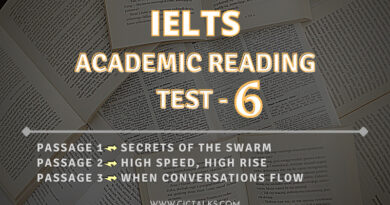IELTS Online General Reading TEST 2023
The Penny Black – IELTS Reading Passage With Answers
| It might not have looked very impressive, but the Penny Black, now 170 years old, was the first stamp to be created and it launched the modem postal system in Britain. Before 1840 and the arrival of the Penny Black, you had to be rich and patient to use the Royal Mail. Delivery was charged according to the miles travelled and the number of sheets of paper used; a 2-page letter sent from Edinburgh to London, for example, would have cost 2 shillings, or more than £7 in today’s money. And when the top-hatted letter carrier came to deliver it, it was the recipient who had to pay for the postage. Letter writers employed various ruses to reduce the cost, doing everything possible to cram more words onto a page. Nobody bothered with heavy envelopes; instead, letters would be folded and sealed with wax. You then had to find a post office – there were no pillar boxes – and hope your addressee didn’t live in one of the several rural areas which were not served by the system. If you were lucky, your letter would arrive (it could take days) without being read or censored. The state of mail had been causing concern throughout the 1830s, but it was Rowland Hill, an inventor, teacher and social reformer from Kidderminster, who proposed a workable plan for change. Worried that a dysfunctional, costly service would stifle communication just as Britain was in the swing of its second industrial revolution, he believed reform would ease the distribution of ideas and stimulate trade and business, delivering the same promise as the new railways. Hill’s proposal for the penny post, which meant any letter weighing less than half an ounce (14 grams) could be sent anywhere in Britain for about 30p in today’s money, was so radical that the Postmaster General, Lord Lichfield, said, ‘Of all the wild and visionary schemes which I ever heard of, it is the most extravagant.’ Lord Lichfield spoke for an establishment not convinced of the need for poor people to post anything. But merchants and reformers backed Hill. Soon the government told him to make his scheme work. And that meant inventing a new type of currency. Hill quickly settled on ‘a bit of paper covered at the back with a glutinous wash which the user might, by applying a little moisture, attach to the back of a letter’. Stamps would be printed in sheets of 240 that could be cut using scissors or a knife. Perforations would not arrive until 1854. The idea stuck, and in August 1839 the Treasury launched a design competition open to ‘all artists, men of science and the public in general’. The new stamp would need to be resistant to forgery, and so it was a submission by one Mr Cheverton that Hill used as the basis for one of the most striking designs in history. Cheverton, who worked as a sculptor and an engineer, determined that a portrait of Queen Victoria, engraved for a commemorative coin when she was a 15-year-old princess, was detailed enough to make copying difficult, and recognisable enough to make fakes easy to spot. The words ‘Postage’ and ‘One Penny’ were added alongside flourishes and ornamental stars. Nobody thought to add the word ‘Britain’, as it was assumed that the stamps would solely be put to domestic use. With the introduction of the new postal system, the Penny Black was an instant hit, and printers struggled to meet demand. By the end of 1840, more than 160 million letters had been sent – more than double the previous year. It created more work for the post office, whose reform continued with the introduction of red letter boxes, new branches and more frequent deliveries, even to the remotest address, but its lasting impact on society was more remarkable. Hill and his supporters rightly predicted that cheaper post would improve the ‘diffusion of knowledge’. Suddenly, someone in Scotland could be reached by someone in London within a day or two. And as literacy improved, sections of society that had been disenfranchised found a voice. Tristram Hunt, an historian, values the ‘flourishing of correspondence’ that followed the arrival of stamps. ‘While I was writing my biography of Friedrich Engels I could read the letters he and Marx sent between Manchester and London,’ he says. ‘They wrote to each other three times a day, pinging ideas back and forth so that you can almost follow a real-time correspondence.’ The penny post also changed the nature of the letter. Weight-saving tricks such as cross-writing began to die out, while the arrival of envelopes built confidence among correspondents that mail would not be stolen or read. And so people wrote more private things – politically or commercially sensitive information or love letters. ‘In the early days of the penny post, there was still concern about theft,’ Hunt says. ‘Engels would still send Marx money by ripping up five-pound notes and sending the pieces in different letters.’ But the probity of the postal system became a great thing and it came to be expected that your mail would not be tampered with. For all its brilliance, the Penny Black was technically a failure. At first, post offices used red ink to cancel stamps so that they could not be used again. But the ink could be removed. When in 1842, it was determined that black ink would be more robust, the colour of the Penny Black became a sort of browny red, but Hill’s brainchild had made its mark. |
Questions 28-30
Choose the correct letter – A, B, C or D.
Write the correct letter in boxes 28-30 on your answer sheet.
28) One of the characteristics of the postal service before the 1840’s was that …
A. postman were employed by various organizations.
B. letters were restricted to a certain length.
C. distance affected the price of postage.
D. the price of delivery kept going up.
29) Letter writers in the 1830’s …
A. were not responsible for the cost of delivery.
B. tried to fit more than one letter into an envelope.
C. could only send letters to people living in cities.
D. knew all letters were automatically read by postal staff.
30) What does the text say about Hill in the 1830’s?
A. He was the first person to express concern about the postal system.
B. He considered it would be more efficient for mail to be delivered by rail.
C. He felt that postal service reform was necessary for commercial development.
D. His plan received support from all the important figures of the day.
Questions 31-34
Look at the following statements (Questions 31-34) and the list of people below.
Match each statement with the correct person – A, B, C or D.
Write the correct letter, A-D in boxes 31-34 on your reading answer sheet.
NB You may use any letter more than once.
| List of People |
|---|
| A. Rowland Hill B. Lord Lichfield C. Cheverton D. Tristram Hunt |
| 31) ………………. ➡️ | His inspiration came form a particular picture. |
| 32) ……………….. ➡️ | He claimed that the postal system would lead to the spread of information. |
| 33) ………………. ➡️ | He organised the creation of the first stamp. |
| 34) ………………. ➡️ | He expressed doubts about the plans to change the postal service. |
Questions 35-40
Complete the notes below.
Choose NO MORE THAN TWO WORDS from the passage for each answer.
Write your answers in boxes 35-40 on your answer sheet.
| The Penny Black |
|---|
| 🔘 Design came about as a result of a competition organised by the (35) …………………… 🔘 Based on an engraving of Queen Victoria featured on a (36) …………………… 🔘 Apart from the Queen’s face, the stamp had just three words and pictures of (37) …………………… as decoration 🔘 No mention of (38) ……………………, as plan was for stamps to be for domestic use only 🔘 The (39) ……………………, which was applied to indicate that the stamp had been used, proved to be ineffective 🔘 In 1842, the (40) …………………… of the stamp was changed |
Some places to visit reading answers
Ans 1 ➡️ E
Ans 2 ➡️ B
Ans 3 ➡️ A
Ans 4 ➡️ F
Ans 5 ➡️ C
Ans 6 ➡️ A
Ans 7 ➡️ C
Ans 8 ➡️ B
LearnWithUs courses reading answers
Ans 9 ➡️ TRUE
Ans 10 ➡️ NOT GIVEN
Ans 11 ➡️ NOT GIVEN
Ans 12 ➡️ TRUE
Ans 13 ➡️ FALSE
Ans 14 ➡️ FALSE
The benefits of having a business mentor reading answers
Ans 15 ➡️ VOLUNTEERS
Ans 16 ➡️ CONSULTANTS
Ans 17 ➡️ DECISIONS
Ans 18 ➡️ EFFICIENCY
Ans 19 ➡️ CONFIDENCE
Ans 20 ➡️ INVOLVEMENT
A planning process for middle-sized projects reading answers
Ans 21 ➡️ AIM
Ans 22 ➡️ RANGE
Ans 23 ➡️ SELECTION
Ans 24 ➡️ DETAILS
Ans 25 ➡️ EVALUATION
Ans 26 ➡️ IMPLEMENTATION
Ans 27 ➡️ LESSONS
The Penny Black reading answers
Ans 28 ➡️ C
Ans 29 ➡️ A
Ans 30 ➡️ C
Ans 31 ➡️ C
Ans 32 ➡️ A
Ans 33 ➡️ A
Ans 34 ➡️ B
Ans 35 ➡️ TREASURY
Ans 36 ➡️ (COMMEMMORATIVE) COIN
Ans 37 ➡️ (ORNAMENTAL) STARS
Ans 38 ➡️ BRITAIN
Ans 39 ➡️ (RED) INK
Ans 40 ➡️ COLOUR / COLOR
About IELTS Online General Reading Test 2023
IELTS General Reading online test 2023 difficulty is classified as ‘Moderate-to-Difficult’. So, if you are scoring 28+/40 in this practice test you are highly likely to hit band 7 and above in the real exam setting.
I hope you find this 11th test of our online ‘READING 150+📖 Practice Test Series’ useful. If you need a PDF copy of this test, tell us in the comment section below.



